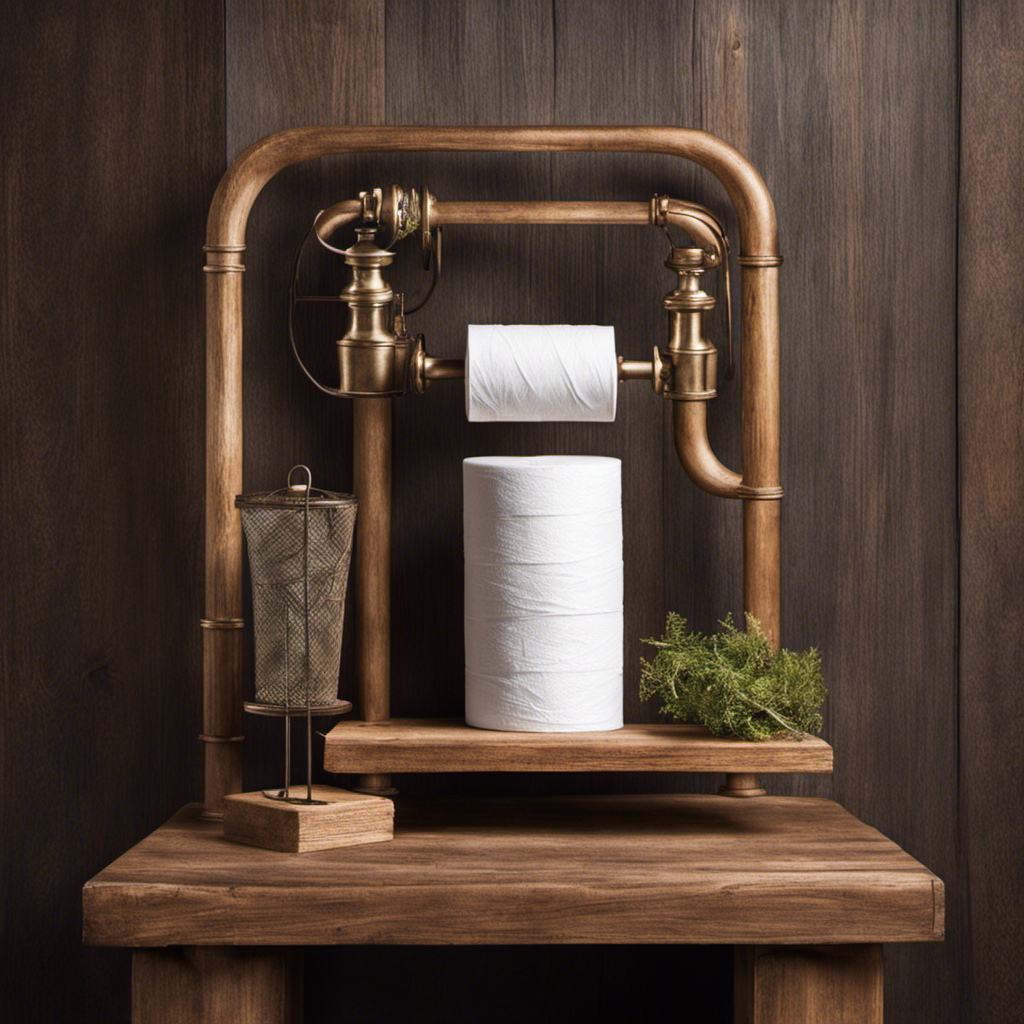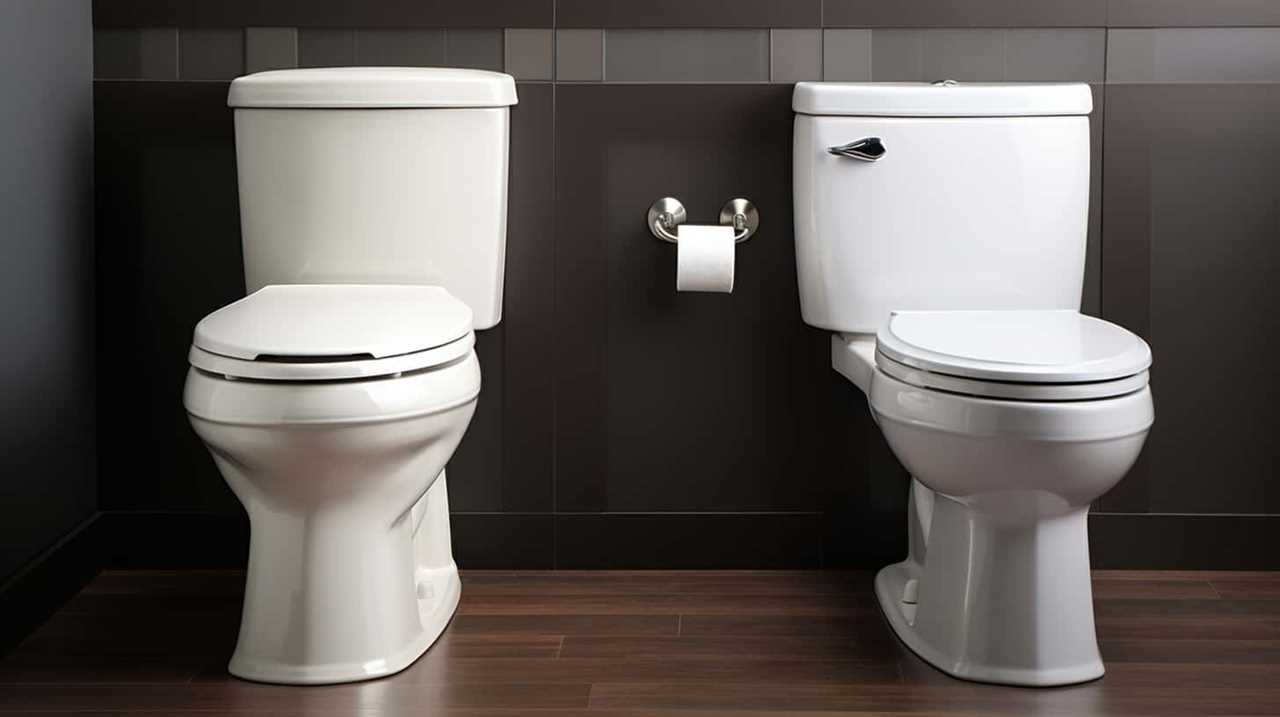As I sit here on my plush bathroom throne, it’s hard to imagine a time when toilet paper didn’t exist. Yet, there was a time when our ancestors relied on much less comfortable methods for maintaining cleanliness.
In this article, we will delve into the fascinating origins of toilet paper, tracing its journey from ancient sanitary practices to the innovative developments of the Industrial Revolution. Join me on this historical exploration as we uncover the answer to the burning question: what year was toilet paper invented?
Key Takeaways
- Toilet paper was first invented in China in the 6th century.
- It spread to other parts of Asia and reached Europe in the 16th century.
- Transitioning to modern toilet paper required innovation and advancements in technology.
- The industrial revolution transformed toilet paper production, making it efficient, affordable, and widely available.
The Origins of Toilet Paper
Toilet paper was first invented in China in the 6th century. The origins of toilet paper can be traced back to the ancient Chinese society, where it was initially used by the wealthy and privileged.
The historical development of toilet paper involved the use of various materials, including bamboo, hemp, and even silk. These materials were carefully crafted into thin sheets and used for personal hygiene purposes.
Over time, the use of toilet paper spread to other parts of Asia and eventually reached Europe in the 16th century. It wasn’t until the 19th century that toilet paper became more widely available and affordable for the general population.
Today, toilet paper is an essential household item that is used by people all over the world.
Ancient Sanitary Practices
Throughout history, the way people have dealt with their bodily waste and maintained hygiene has varied greatly. Early toilet alternatives included chamber pots, which were emptied into the streets, and latrines, which were communal spaces.
Hygiene practices throughout history have also evolved, with ancient societies using various methods such as water, sand, or even leaves to clean themselves. The role of sanitation in ancient societies was crucial for maintaining public health and preventing the spread of disease, as seen in the advanced sewer systems of civilizations like the Indus Valley and ancient Rome.
Early Toilet Alternatives
Before the invention of toilet paper, people used various alternatives for personal hygiene. Early toilet inventions and historical bathroom practices reveal the ingenuity and resourcefulness of our ancestors.
In ancient times, water was often used for cleansing, with people using their hands or a cloth to clean themselves after using the bathroom. The Romans, on the other hand, used a communal sponge attached to a stick, which was shared by multiple individuals. In medieval Europe, straw, leaves, or even hay were used as makeshift toilet paper. These alternatives were not as convenient or effective as the modern invention of toilet paper, but they served their purpose in maintaining personal hygiene.
Transitioning into the subsequent section on hygiene practices throughout history, it is interesting to see how different cultures and time periods have approached the issue of cleanliness.
Hygiene Practices Throughout History
Throughout history, people have devised various methods to maintain personal hygiene, showcasing their resourcefulness and creativity. Hygiene practices have been influenced by cultural customs and have evolved over time.
Here are four notable hygiene practices from different cultures:
-
Ancient Romans used communal bathhouses for cleansing and socializing, emphasizing cleanliness as a cultural norm.
-
In ancient Egypt, wealthy individuals used perfumed oils and powders to keep their bodies clean and smelling pleasant.
-
Traditional Japanese culture places great emphasis on cleanliness and ritualistic bathing, with public bathhouses still being popular today.
-
Native American tribes often used herbal remedies and natural materials like corn cobs or leaves for hygiene purposes.
These examples demonstrate how hygiene practices have varied across cultures, highlighting the importance of maintaining cleanliness in different societies.
Role of Sanitation in Ancient Societies
Sanitation played a crucial role in maintaining the health and well-being of ancient societies. The practices and beliefs surrounding sanitation varied greatly across different cultures. In ancient Rome, for example, public baths were not only places for cleansing the body, but also for socializing and conducting business. On the other hand, in ancient Egypt, cleanliness was closely tied to religious rituals, with purification rites being performed regularly. To emphasize the importance of sanitation in ancient societies, I have created a table below:
| Ancient Society | Sanitation Practices | Cultural Beliefs |
|---|---|---|
| Rome | Public baths | Socialization |
| Egypt | Purification rites | Religious |
The First Recorded Use of Toilet Paper
Did you know that the first recorded use of toilet paper dates back to the 6th century in China? The historical significance of this early invention cannot be overstated. Here are four key points to consider:
-
The first documented use of toilet paper in China was credited to the Emperor Wen of Sui. He ordered large sheets of paper to be made for his personal use in the palace.
-
These early toilet papers were made from soft materials such as hemp, linen, and mulberry bark.
-
The use of toilet paper quickly spread among the Chinese nobility and eventually to the general population.
-
It wasn’t until the 14th century that toilet paper started to be used in other parts of the world, such as the Muslim world and medieval Europe.
With the first recorded use of toilet paper in China, it marked the beginning of a long and ever-evolving journey towards improving sanitation practices. This early innovation paved the way for the development of various materials and techniques in the centuries to come.
Early Innovations in Toilet Paper
When it comes to the topic of toilet paper, it’s fascinating to explore the ancient alternatives that people used before the evolution of modern TP. From leaves and grass to corn cobs and seashells, our ancestors found creative ways to clean themselves after using the bathroom.
As time went on, the invention of paper and the advancements in technology led to the development of the toilet paper we know and use today.
Ancient Toilet Paper Alternatives
People in ancient civilizations used various materials like plant leaves and stones as alternatives to toilet paper. The historical bathroom rituals of these civilizations were vastly different from our modern practices. Here are four examples of toilet paper substitutes used in ancient times:
-
Plant Leaves: Leaves from plants like mulberry, coconut, and lotus were commonly used as toilet paper substitutes. These leaves were soft and easily accessible in nature.
-
Corn Cobs: In some cultures, corn cobs were used as a toilet paper alternative. The rough texture of the cob served as a makeshift cleaning tool.
-
Papyrus: Ancient Egyptians used strips of papyrus, a plant-based material, as a form of toilet paper. This was a more luxurious option compared to leaves or stones.
-
Wool: In colder regions, people used wool scraps or sheepskin as a toilet paper substitute. The softness and absorbency of wool made it a practical choice.
Understanding the historical use of these toilet paper substitutes gives us insight into the resourcefulness and ingenuity of ancient civilizations.
Evolution of Modern TP
To truly appreciate the convenience of modern toilet paper, you can’t help but marvel at how it has evolved over time. From its humble origins as a substitute for leaves and other natural materials, toilet paper has undergone significant evolutionary advancements.
The first notable improvement came in the 19th century when commercially produced paper rolls became available. This development revolutionized personal hygiene practices, providing a more sanitary and efficient solution. Over the years, toilet paper has continued to evolve, with advancements in softer and stronger materials, as well as the introduction of various textures and scents.
However, it’s important to consider the environmental impact of toilet paper production and usage. The increased demand for toilet paper has led to deforestation and pollution, highlighting the need for more sustainable alternatives.
Transitioning into the subsequent section, the industrial revolution played a crucial role in shaping the future of toilet paper.
The Industrial Revolution and Toilet Paper
During the Industrial Revolution, the manufacturing process for toilet paper significantly improved. Here are four ways in which the industrial revolution revolutionized toilet paper production:
-
Machinery: The invention of steam-powered machines allowed for faster and more efficient production of toilet paper. This eliminated the need for manual labor and increased output.
-
Mass production: With the introduction of mechanized processes, toilet paper production shifted from a labor-intensive craft to a large-scale industrial operation. This led to a significant increase in the availability and affordability of toilet paper.
-
Quality control: Industrialization brought about standardized production methods, ensuring consistent quality in toilet paper. This meant that consumers could rely on the product being consistently soft, absorbent, and durable.
-
Accessibility: The industrial revolution made toilet paper more accessible to a wider population. Increased production and lower costs made it easier for individuals of all socioeconomic backgrounds to afford and use toilet paper.
Overall, the industrial revolution had a transformative impact on toilet paper production, making it more efficient, affordable, and widely available to the masses.
Toilet Paper in the Modern World
With the advancements in technology, you can now find a wide variety of toilet paper options to suit your personal preferences and needs. In recent years, there have been concerns about toilet paper shortages and the impact of this essential product on the environment.
Many companies have taken sustainability measures to address these concerns. They have introduced eco-friendly alternatives such as recycled toilet paper made from post-consumer waste or bamboo, which is a rapidly renewable resource. Additionally, some brands have implemented packaging made from recycled materials and reduced the amount of plastic used.
These sustainability measures aim to minimize the environmental footprint of toilet paper production and consumption. It is encouraging to see that the industry is taking steps towards a more sustainable future.
The Future of Toilet Paper
As we look to the future of toilet paper, it’s important to consider sustainability concerns. While toilet paper has been a staple in our lives for centuries, its production has significant environmental impacts.
To address these concerns, innovative alternatives are being explored. Here are four potential digital alternatives that could shape the future of toilet paper:
-
Bidets: Bidets are water-based alternatives that offer a more hygienic and eco-friendly option. They use water to clean, reducing the need for toilet paper.
-
Smart toilets: These high-tech toilets incorporate advanced features like self-cleaning capabilities and adjustable water pressure, further reducing the reliance on toilet paper.
-
Bamboo-based toilet paper: Bamboo is a highly renewable resource that grows quickly, making it a sustainable alternative to traditional toilet paper.
-
Digital toilet paper: With the rise of technology, it’s possible that digital alternatives such as smart screens or virtual reality experiences could replace physical toilet paper altogether.
While the future of toilet paper may look different, it’s clear that sustainable alternatives are becoming more prominent in our quest for a greener future.
Conclusion
In conclusion, the invention of toilet paper has undoubtedly revolutionized personal hygiene practices throughout history. From ancient civilizations using various materials for cleanliness to the first recorded use of toilet paper in China, this essential invention has come a long way.
Early innovations and the industrial revolution further improved the quality and accessibility of toilet paper. Today, toilet paper is an indispensable part of our modern world, ensuring comfort and cleanliness.
As we look to the future, it is clear that toilet paper will continue to play a vital role in our lives, symbolizing the importance of personal hygiene and well-being.










